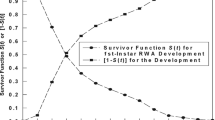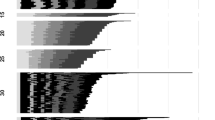Summary
A model is developed for the analysis of insect stage-frequency data which may be applied to populations with age-dependent mortality. The analysis of stage-frequency data is divided into two steps. In the first step, the number of different mortality rates and their values are estimated. The second step provides estimates of developmental rates and variances for each developmental stage and in addition provides estimates of the number of recruits to each stage. The model may be used both in analysis and prediction of insect stage frequencies. Hence, in addition to estimating developmental and mortality rates from stage-frequency data, it may also be used as a simulation model for an insect population. The model is applied to two populations ofHemileuca oliviae Cockerell, a lepidopterous pest of New Mexico grasslands. The model identifies, in the two populations, different mortality rates that are related to plant productivity.
Similar content being viewed by others
References
Bellows, T. S. Jr. (1982) Simulation models for laboratory populations ofCallosobruchus chinensis andC. maculatus. J. Anim. Ecol. 51, in press.
Bellows, T. S. Jr. andM. Birley (1981) Estimating developmental and mortality rates and stage recruitment from insect stage-frequency data.Res. Popul. Ecol. 23: 232–244.
Bellows, T.S. Jr.,J. C. Owens andE. W. Huddleston (1982) A model for simulating consumption and economic injury level for the range caterpillar,Hemileuca oliviae Cockerell.J. Econ. Entomol., in press.
Birley, M. (1977) The estimation of insect density and instar survivorship functions from census data.J. Anim. Ecol. 46: 497–510.
Catana, H. J. (1953) The wandering-quarter method of estimating population density.Ecology 44: 349–360.
Draper, N. andH. Smith (1966)Applied regression analysis. Wiley and Sons, Inc., New York.
Hinkley, D. V. (1969) Inference about the intersection in two phase regression.Biometrica 56: 495–504.
Hudson, D. J. (1966) Fitting segmented curves whose join points have to be estimated.J. Am. Stat. Assoc. 61: 1097–1129.
Manly, B. F. J. (1974a) A comparison of methods for the analysis of insect stage-frequency data.Oecologia 17: 335–348.
Manly, B. F. J. (1974b) Estimation of stage-specific survival rates and other population parameters for insect populations developing through several stages.Oecologia 15: 277–285.
Southwood, T. R. E. (1978)Ecological Methods, 2nd ed. Chapman and Hall, London.
Author information
Authors and Affiliations
Rights and permissions
About this article
Cite this article
Bellows, T.S., Ortiz, M., Owens, J.C. et al. A model for analyzing insect stage-frequency data when mortality varies with time. Res Popul Ecol 24, 142–156 (1982). https://doi.org/10.1007/BF02515596
Issue Date:
DOI: https://doi.org/10.1007/BF02515596




